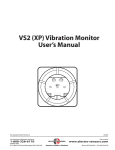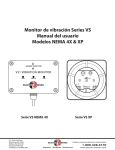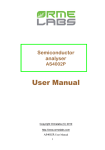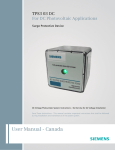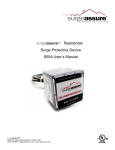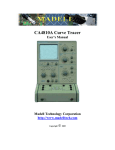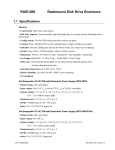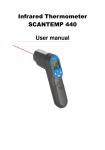Download VS1 Operation Manual - Electro
Transcript
VS1 Vibration Monitor User’s Manual �������������������� ��������������������� ����� ��������� ����� Part Number 990-001100 Rev. E 082903 ���������������� ���������������������������������������� ����������������������� �������������� ������������ ������������������������������������������������� ������������������������������ ����������������������������������������� Description The VS1 Vibration Monitor combines sensor, circuitry and isolated npn or relay output into a compact NEMA 4X package. It monitors the machine surface to which it is attached and alarms when vibration levels either exceed or fall below the trip-point setting (depending on the ALARM switch setting). Operator Interface/Dimensions The setting dials and switch are located under the waterproof cover. Remove the cover to change settings and replace when finished. Cover Removed ����� � � ��� ��� � � �� ��� � � ��� �� � � ��� �� �� ���������� �������� ����� ���� ����� ���� ���� ���� ����� ����� ����� �� ��������� ��� ��� ��� ���� ����� ����� Cover Attached ����� ����� ����� ����� ����� ����� Installation Orientation The VS1 senses vibration along the axis indicated by the SENSING DIRECTION arrow. Orient the VS1 with the arrow parallel to the vibration axis to be monitored. Mounting The VS1 enclosure has four mounting holes. The mounting holes are the same as the cover attachment holes (located directly underneath the captive cover screws when the cover is on). Remove the cover to access the mounting holes (see Operator Interface/ Dimensions). Use four 8-32 UNC (or M4 metric) hex socket-head cap screws to mount the VS1. Rigid, tight attachment is necessary for any vibration-sensing device. For this reason the VS1 must be securely fastened to a smooth, flat surface. Use all four screws: mounting with fewer can allow error-causing resonance when high-frequency vibrations are present. Cabling The VS1 comes standard with a 10' cable. When extending the cable to a longer length, terminate it in an appropriate junction box with proper terminal strips. The cable wires have the following color code: Power Green Red Black Case DC Power (+) DC Power (-) NPN Output Option Relay Output Option Blue Orange White Blue Orange White Collector Protection Cathode Emitter Collector ���������������� ���������������������������������������� ����������������������� �������������� ������������ ������������������������������������������������� Relay Common Relay N.C. Relay N.O. ������������������������������ ����������������������������������������� Operation Power LED (Green)............................ Indicates power applied to the VS1. Vibration LED (Green) .................... Indicates vibration at or above the minimum detectable level (0.1 in/s nominal). Alarm LED (Red)................................. Indicates an alarm condition. Note: Alarms are not latching — an alarm condition persists only while the vibration magnitude stays at alarm levels. Alarm OVER/UNDER Switch ....... Selects the alarm functionality. Over: Alarms while vibration magnitude is above the trip-point setting. Under: Alarms while vibration magnitude is below the trip-point setting. Trip-Point Dial ................................... Sets the alarm level threshhold in inches-per-second RMS. Delay Dial ............................................ Sets the alarm delay in seconds. An alarm occurs DELAY seconds after detecting vibration magnitude at alarm level. The vibration magnitude must remain at alarm levels for at least DELAY seconds for an alarm to occur. NPN Output Option ....................... The isolated NPN output is connected for failsafe operation (NPN on when powered and not alarmed). It operates as follows: Conducting (ON) when VS1 is powered and not alarmed Not conducting (OFF) when VS1 is unpowered or alarmed. Relay Output Option ..................... The isolated SPDT relay is connected for failsafe operation (relay is energized when VS1 is powered and not alarmed). The contacts operate as follows: N.C. Disconnected from COM (energized) when VS1 is powered and not alarmed. Connected to COM (not energized) when VS1 is unpowered or alarmed. N.O. Connected to COM (energized) when VS1 is powered and not alarmed. Disconnected from COM (not energized) when VS1 is unpowered or alarmed. Settings With the VS1 tightly mounted, the cover removed, and 24 Vdc power applied*, complete the following steps: 1. Set the ALARM OVER/UNDER switch as required. 2. Set the TRIP-POINT. If the desired RMS velocity alarm value is known, set the trip point to that value, otherwise it can be set experimentally relative to your machine’s current (acceptable) vibration level. The following gives an example (ALARM set to OVER): a. Set the DELAY to minimum (1 second). b. Start the machine to be monitored. Note: The VIBRATION LED should light, indicating vibrations above the VS1 minimum detectable level (0.1 in/s). Wait for any/all transient vibrations to die out. c. Slowly increase the TRIP POINT setting until the ALARM LED darkens (if already alarmed). d. Slowly decrease the TRIP POINT setting until the ALARM LED begins to light. This setting is your current vibration level. Note: These last two steps may need to be repeated. Adjust the TRIP POINT slowly since there is a minimum of 1 second response time. e. Increase the TRIP POINT to a value proportional to the current vibration level. For example, if the current vibration level is 0.5 in/s and you want the VS1 to alarm at 40% above that, set the trip point to 0.7 in/s. 3. Set the DELAY. This may also have to be determined experimentally, depending on the duration of vibration transients to be ignored. 4. Re-attach the cover tightly. * Note: There is a 2-3s. delay from application of DC power to becoming operational (to allow internal circuitry to charge). ���������������� ���������������������������������������� ����������������������� �������������� ������������ ������������������������������������������������� ������������������������������ ����������������������������������������� Specifications LED Indicators Isolated NPN Output (NPN output option) Power...............................................................Green Vibration.........................................................Green - indicates vibration above min. detectable level (0.1 in/s rms) Alarm ..............................................................Red - indicates output in alarm state Current ............................................................50 mA VCE (max @ 50 mA).......................................1.0 V BVCEO (breakdown volts)............................100 V PD (max power over temp) .......................100 mW ICEO (max leakage over temp)...................100 µA Failsafe.............................................................Transistor ON when powered and not alarmed Settings/Ranges Alarm trip point............................................0.1 - 2.2 in/s (2.5 - 55 mm/s) rms Alarm delay....................................................1 - 10 seconds Alarm ..............................................................Over/under select switch Terminals/Connections Cable ................................................................6 conductor, unshielded, 22 AWG NPN Option Relay Option Green ...............................................................Case Case Red....................................................................DC Power (+) DC Power (+) Black .................................................................DC Power (-) DC Power (-) Blue...................................................................Collector Protection Relay Common Cathode Orange ............................................................Emitter Relay N.C. White................................................................Collector Relay N.O. Operational Limits Min. vibration frequency (-3db) .............10 Hz Max. vibration acceleration......................± 50 g peak (NPN option) ± 12 g peak (Relay option) Power Requirements Voltage ............................................................24 Vdc (18 - 30 Vdc) Current (max)................................................30 mA @ 24 Vdc Note: Optional 24 Vdc/130 mA power supply available, consult factory. Environmental Operating Temperature ...........................-40oC to 65oC (-40oF to 149oF) Enclosure type..............................................Cast aluminum, NEMA 4X Relay (Relay option) Type..................................................................SPDT DC rating ........................................................5A @ 30 Vdc AC rating.........................................................5A @250 Vac Failsafe.............................................................Relay energized when powered and not alarmed Mechanical Weight .............................................................0.75 lb (0.34 kg) Dimensions....................................................3.94" x 2.56" x 1.66" Specifications subject to change without notice. NPN Output Schematic and Possible Connections (NPN Output Option) ��� ��� ��� ��� � Relay Output Schematic (Relay Output Option) ��� ��� ��� ��� ��� ��� ������ � ��� ��� ��� ��� ����� ��� ��� ��� ��� ������ � ��� ��� ��� ��� Sinking (resistive load) Sinking (inductive load) ��� ��� Sourcing (resistive load) The NPN output is electrically isolated from the VS1 DC power inputs and case. The NPN output may be externally connected to the same supply as the DC power inputs or to a different supply. The relay output is electrically isolated from the VS1 DC power inputs and case Useful Conversion Formulas Definitions: CPM f Stroke Disppk Machine cycles per minute Frequency Max machine travel (peak to peak) Peak displacement from center position (Stroke / 2) Formulas: f (frequency in Hz) Velrms (rms velocity in in/s) Accel (peak acceleration in g’s) Accel (peak acceleration in g’s) = CPM / 60 = 4.44 * Disppk * f = 0.103 * Disppk * f2 = 0.0231 * Velrms * f Note: All formulas based on sinusoidal motion. Disppk must be in inches, f must be in Hz Disppk must be in inches, f must be in Hz Velrms must be in in/s rms, f must be in Hz ���������������� ���������������������������������������� ����������������������� �������������� ������������ ������������������������������������������������� ������������������������������ �����������������������������������������




